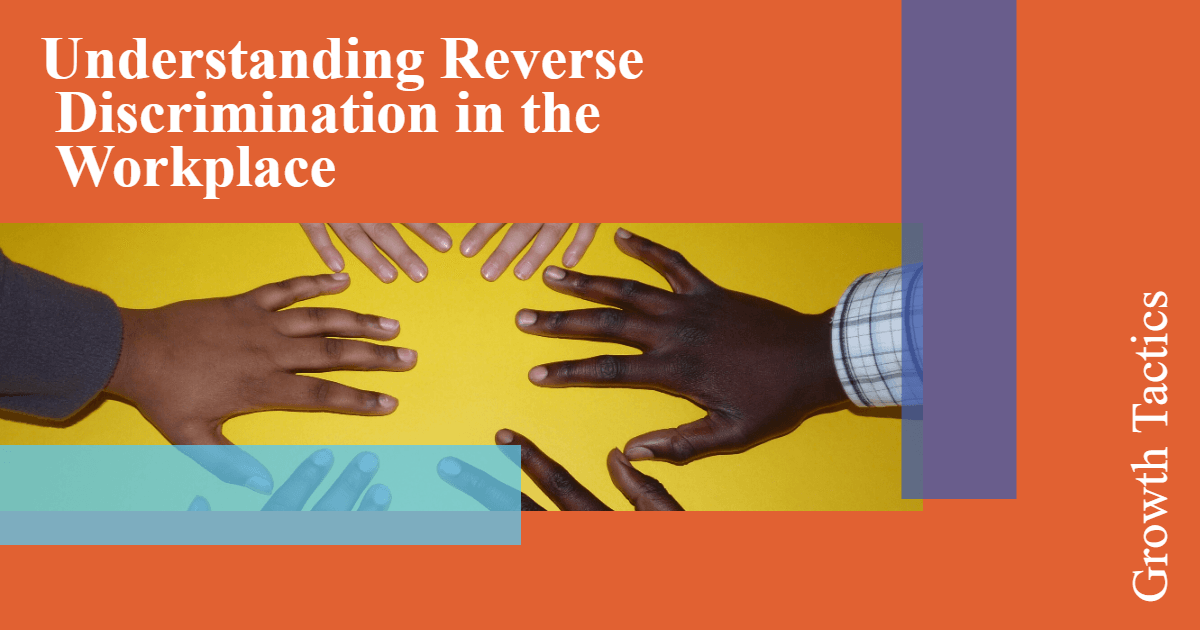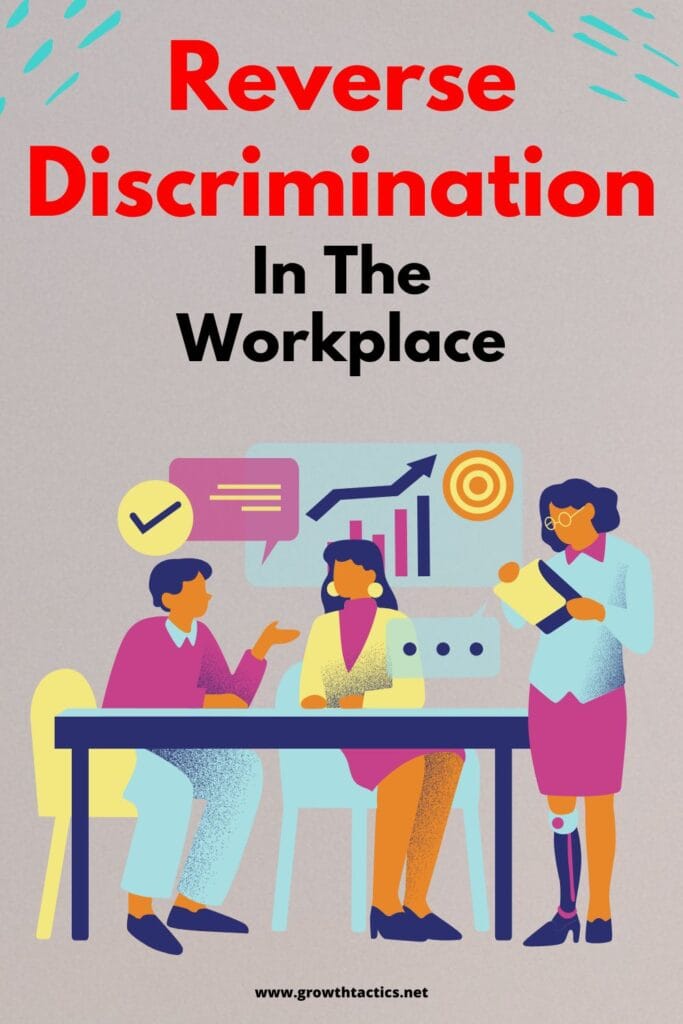Feeling like you’re treated unfairly at work can be frustrating. When people talk about discrimination, they usually mean how minorities are treated. But have you ever wondered if too much focus on one group can hurt another?
This is called reverse discrimination. It’s a growing concern and it’s important to understand what it is, why it happens, and how it affects everyone in the workplace. Let’s hop in and explore this complex issue together.
Jump To Section
What is Reverse Discrimination?
Reverse discrimination happens when policies meant to help minorities end up unfairly disadvantaging members of the majority group. For example, you might feel like a qualified candidate was overlooked for a promotion because the company wanted to hire someone from a minority group instead. It’s basically discrimination in the workplace but in the opposite direction.
Why Does Reverse Discrimination Happen?
The idea stems from efforts to create a more diverse and inclusive workplace. Programs like affirmative action and DEI (Diversity, Equity, and Inclusion) initiatives are essential for promoting equality.
They aim to level the playing field for minorities who have historically been underrepresented or marginalized. These programs have noble intentions: to offer equal opportunities to everyone, regardless of their background.
Affirmative action and DEI initiatives can take many forms, such as targeted recruitment strategies, scholarships, mentorship programs, and diversity training sessions. These efforts are implemented to ensure that minorities have a fair chance of competing in arenas traditionally dominated by the majority group.
However, sometimes these programs can inadvertently create a perception or reality where the majority group members feel sidelined. For instance, an organization might set diversity quotas to ensure sufficient representation of minorities.
While this can promote fairness, it might also mean that some majority group members feel they are being overlooked purely based on their race, gender, or another characteristic. The balancing act is challenging, and it’s easy for well-intentioned policies to have unintended side effects.
Moreover, the rapid pace at which organizations are trying to implement these initiatives can sometimes outpace the development of fair oversight mechanisms. This can result in decisions that, while aiming to be inclusive, end up making some employees feel excluded or unfairly treated.
Legal Framework
The law gets pretty complicated when it comes to reverse discrimination. Laws like the Civil Rights Act and Equal Employment Opportunity laws were crafted to protect minorities, but they also apply to everyone, including the majority group. These laws are designed to ensure that no one faces discrimination based on race, color, religion, sex, or national origin.
Over the years, several court cases have set the stage for how reverse discrimination claims are viewed. For example, cases like Regents of the University of California v. Bakke and Ricci v. DeStefano have highlighted the complexities involved in balancing affirmative action with the rights of majority group members. These legal precedents hold that while affirmative action programs are constitutionally permissible, they cannot unduly harm members of the majority group.
Understanding these legal frameworks and case laws can help you understand your rights if you feel like you’ve been discriminated against. It’s crucial to know that the laws are there to protect everyone, and you have a legal standing if you believe you’ve been treated unfairly due to reverse discrimination.
Recognizing Reverse Discrimination
So, how can you tell if you’re experiencing reverse discrimination? Look out for scenarios like feeling excluded from job promotions, training programs, or other opportunities solely because you are part of the majority group. It might also manifest in workplace conversations or policies that seem to favor one group over another unfairly.
However, it’s important to distinguish between legal discrimination and perceived unfairness. Not every feeling of unfair treatment qualifies legally as discrimination. For example, if you are not selected for a position because another candidate (regardless of their background) is more qualified, that’s not discrimination. On the other hand, if the decision is made explicitly based on race, gender, or another protected characteristic, then it might be a case of reverse discrimination.
Understanding these nuances can help you navigate your workplace better and advocate for fair treatment for everyone. If you’re unsure, consulting HR policies or talking to a legal expert can provide clarity.
Steps to Take If You Think You’re a Victim of Reverse Discrimination
If you believe you’re a victim of reverse discrimination, it’s important to take the appropriate steps to address the situation. Here’s a detailed guide on what you can do:
1. Document the Incidents
- Keep Records: Document every instance of what you perceive as reverse discrimination. Record dates, times, locations, individuals involved, and details of the incidents. Also, note any communications (emails, memos, etc.) that are relevant.
- Specific Examples: Be as specific as possible in your documentation. For instance, “On July 1, during our weekly team meeting, I was told I was not eligible for the upcoming training program due to needing more minority representation in the cohort.”
2. Review Your Company’s Policies
- Employee Handbook: Consult your employee handbook to understand your company’s internal grievance procedures.
- Discrimination Policies: Review the company’s policies on discrimination to ensure you are aware of your rights and the steps your employer has committed to taking in such instances.
3. Use Internal Grievance Procedures
- Report the Issue: Follow the outlined steps in your company’s internal grievance procedure. This might involve speaking to your manager, HR representative, or a designated compliance officer.
- Submit a Formal Complaint: If necessary, submit a formal written complaint detailing your concerns and providing your documented evidence.
4. Seek Mediation or Conflict Resolution
- Mediation Services: Your company may offer mediation services or conflict resolution resources. This can be an effective way to address your concerns in a structured and neutral setting.
5. Contact an Attorney Specializing in Discrimination Cases
- Legal Counsel: If the internal grievance procedure does not resolve the issue to your satisfaction, consider consulting an attorney who specializes in employment law and discrimination cases.
- Legal Advice: An attorney can provide advice on the strength of your case, the best course of action, and any potential outcomes.
6. File a Claim with the Equal Employment Opportunity Commission (EEOC)
- EEOC Complaint: You can file a complaint with the EEOC if you believe you have been unlawfully discriminated against. This federal agency enforces laws against workplace discrimination.
- Timeliness: Be aware of the deadlines for filing a discrimination complaint with the EEOC. Typically, you need to file within 180 days of the discriminatory act, although this can extend to 300 days in some jurisdictions.
- Investigation: The EEOC will investigate your claim, which may result in mediation, a settlement, or a lawsuit if necessary.
7. Stay Informed and Assert Your Rights
- Understand Your Rights: Familiarize yourself with your legal rights. The Civil Rights Act, Age Discrimination in Employment Act, and other laws protect against discrimination for everyone, including the majority groups.
- Advocate: Assertively yet professionally advocate for yourself throughout the process.
8. Follow Up
- Tracking Progress: Keep track of all communications and developments regarding your case. Follow up with your company, attorney, or the EEOC as needed to ensure your complaint is being addressed.
9. Seek Emotional and Professional Support
- Support Systems: Dealing with claims of discrimination can be emotionally taxing. Seek support from friends, family, or professional counselors.
- Professional Networking: Engage with professional organizations or support groups that can offer guidance and assistance.
10. Be Prepared for Potential Outcomes
- Realistic Expectations: Understand that the resolution process can take time and the outcomes can vary. Be prepared for different scenarios, including potentially finding a new job if the workplace environment does not improve.
Taking these steps can help you navigate your situation more effectively. Remember that you have the right to a fair and equitable work environment, and there are resources available to help you address any issues of reverse discrimination. Keep informed, document everything, and seek the appropriate assistance to ensure your rights are protected.
Preventing Reverse Discrimination
Organizations have a responsibility to create a balanced and inclusive work environment that treats every employee fairly, regardless of their background. Here are detailed steps companies can take to prevent reverse discrimination:
Implement Fair Employment Practices
- Equal Opportunity Policies: Establish clear, written policies that emphasize equal opportunity for all employees. These should state that hiring, promotions, and other employment decisions are based on individual qualifications and merit.
- Uniform Application of Policies: Ensure that these policies are consistently applied across all departments and levels within the organization.
Regular Training and Education
- Diversity and Inclusion Training: Conduct regular training sessions on diversity and inclusion that are mandatory for all employees. These sessions should cover the importance of fairness and the potential risks of reverse discrimination.
- Bias Awareness: Include training on recognizing and mitigating unconscious bias. Help employees understand how biases can affect decision-making processes and lead to unintended discrimination.
Transparent Policies and Communication
- Clear Criteria for Promotions and Rewards: Develop and communicate transparent criteria for promotions, bonuses, and other rewards. Ensure these criteria are based on job performance, skills, and qualifications, rather than demographic factors.
- Open Dialogue: Foster an environment where employees feel comfortable discussing concerns about discrimination, including reverse discrimination. Encourage open and honest communication between management and staff.
Continuous Evaluation of DEI Initiatives
- Regular Audits: Conduct regular audits of DEI initiatives to assess their impact and ensure they are not inadvertently leading to reverse discrimination. Adjust programs as needed based on audit findings.
- Feedback Mechanisms: Implement mechanisms for employees to provide anonymous feedback on DEI initiatives. Use this feedback to make informed adjustments to ensure fairness for all groups.
Balanced Diversity Programs
- Inclusive Recruiting Practices: While focusing on diversity, ensure recruiting practices do not exclude qualified majority group candidates. Aim for a balanced approach that values diversity without compromising on qualifications.
- Mentorship and Support for All: Provide mentorship and career development opportunities for all employees, regardless of their background. Ensure minority mentorship programs exist alongside initiatives that support majority employees as well.
Implement a Robust Grievance Procedure
- Accessible Reporting Channels: Make it easy for employees to report perceived discrimination, including reverse discrimination. Provide multiple channels for reporting issues, such as hotlines, online forms, and designated HR representatives.
- Fair Investigation: Commit to investigating all complaints thoroughly and impartially. Ensure investigators receive training in handling discrimination cases fairly and without bias.
Senior Leadership Commitment
- Top-Down Approach: Senior leaders should publicly commit to promoting equality and preventing all forms of discrimination. This commitment should be visible in company policies, actions, and culture.
- Role Models: Encourage senior leaders to be role models in promoting fairness and inclusivity. Their behavior sets the tone for the entire organization.
Promote a Culture of Fairness
- Equal Value of Perspectives: Cultivate a culture where the perspectives and contributions of all employees are equally valued. Recognize and celebrate the achievements of both minority and majority group members.
- Team Dynamics: Create teams that are diverse and inclusive, ensuring that no group feels marginalized or exclusively favored.
Legally Compliant Practices
- Legal Guidance: Regularly consult with legal experts to ensure that company policies and practices are compliant with current employment laws. Stay updated on legal precedents and emerging issues related to discrimination.
- Risk Management: Develop a risk management plan that includes strategies for addressing potential claims of reverse discrimination.
Promote Transparency in DEI Goals
- Clear Objectives: Set clear, measurable DEI goals that are communicated to all employees. Ensure these goals promote inclusivity without creating perceived favoritism.
- Achievable Targets: Balance ambitious diversity targets with the practical aspects of merit-based selection processes.
By proactively addressing the potential for reverse discrimination, companies can foster a harmonious workplace where diversity truly enriches the organizational culture.
Conclusion
Reverse discrimination is a complex issue, but it’s important for everyone in the workplace to feel they’re treated fairly. By understanding what reverse discrimination is, why it happens, and how to address it, we can work towards a more inclusive and fair work environment for all. Keep these points in mind and help make your workplace a space where everyone feels valued and respected.








